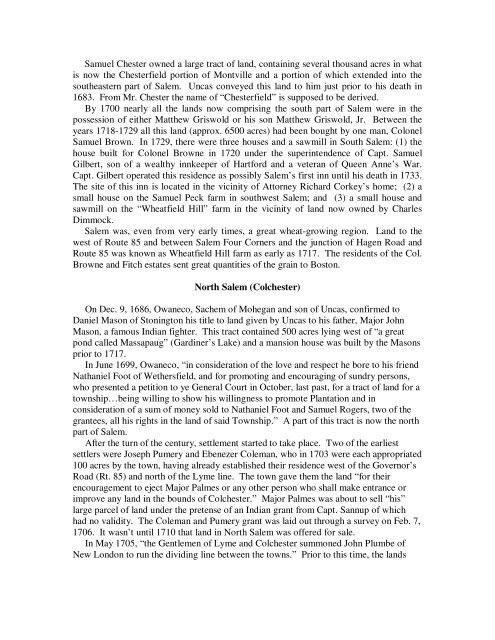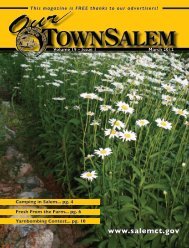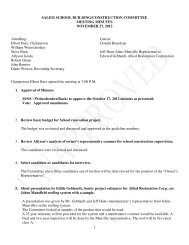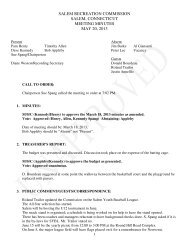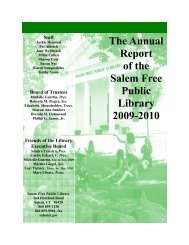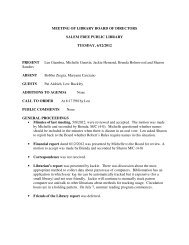HISTORICAL SKETCHES OF SALEM, CONNECTICUT The town of ...
HISTORICAL SKETCHES OF SALEM, CONNECTICUT The town of ...
HISTORICAL SKETCHES OF SALEM, CONNECTICUT The town of ...
You also want an ePaper? Increase the reach of your titles
YUMPU automatically turns print PDFs into web optimized ePapers that Google loves.
Samuel Chester owned a large tract <strong>of</strong> land, containing several thousand acres in what<br />
is now the Chesterfield portion <strong>of</strong> Montville and a portion <strong>of</strong> which extended into the<br />
southeastern part <strong>of</strong> Salem. Uncas conveyed this land to him just prior to his death in<br />
1683. From Mr. Chester the name <strong>of</strong> “Chesterfield” is supposed to be derived.<br />
By 1700 nearly all the lands now comprising the south part <strong>of</strong> Salem were in the<br />
possession <strong>of</strong> either Matthew Griswold or his son Matthew Griswold, Jr. Between the<br />
years 1718-1729 all this land (approx. 6500 acres) had been bought by one man, Colonel<br />
Samuel Brown. In 1729, there were three houses and a sawmill in South Salem: (1) the<br />
house built for Colonel Browne in 1720 under the superintendence <strong>of</strong> Capt. Samuel<br />
Gilbert, son <strong>of</strong> a wealthy innkeeper <strong>of</strong> Hartford and a veteran <strong>of</strong> Queen Anne’s War.<br />
Capt. Gilbert operated this residence as possibly Salem’s first inn until his death in 1733.<br />
<strong>The</strong> site <strong>of</strong> this inn is located in the vicinity <strong>of</strong> Attorney Richard Corkey’s home; (2) a<br />
small house on the Samuel Peck farm in southwest Salem; and (3) a small house and<br />
sawmill on the “Wheatfield Hill” farm in the vicinity <strong>of</strong> land now owned by Charles<br />
Dimmock.<br />
Salem was, even from very early times, a great wheat-growing region. Land to the<br />
west <strong>of</strong> Route 85 and between Salem Four Corners and the junction <strong>of</strong> Hagen Road and<br />
Route 85 was known as Wheatfield Hill farm as early as 1717. <strong>The</strong> residents <strong>of</strong> the Col.<br />
Browne and Fitch estates sent great quantities <strong>of</strong> the grain to Boston.<br />
North Salem (Colchester)<br />
On Dec. 9, 1686, Owaneco, Sachem <strong>of</strong> Mohegan and son <strong>of</strong> Uncas, confirmed to<br />
Daniel Mason <strong>of</strong> Stonington his title to land given by Uncas to his father, Major John<br />
Mason, a famous Indian fighter. This tract contained 500 acres lying west <strong>of</strong> “a great<br />
pond called Massapaug” (Gardiner’s Lake) and a mansion house was built by the Masons<br />
prior to 1717.<br />
In June 1699, Owaneco, “in consideration <strong>of</strong> the love and respect he bore to his friend<br />
Nathaniel Foot <strong>of</strong> Wethersfield, and for promoting and encouraging <strong>of</strong> sundry persons,<br />
who presented a petition to ye General Court in October, last past, for a tract <strong>of</strong> land for a<br />
<strong>town</strong>ship…being willing to show his willingness to promote Plantation and in<br />
consideration <strong>of</strong> a sum <strong>of</strong> money sold to Nathaniel Foot and Samuel Rogers, two <strong>of</strong> the<br />
grantees, all his rights in the land <strong>of</strong> said Township.” A part <strong>of</strong> this tract is now the north<br />
part <strong>of</strong> Salem.<br />
After the turn <strong>of</strong> the century, settlement started to take place. Two <strong>of</strong> the earliest<br />
settlers were Joseph Pumery and Ebenezer Coleman, who in 1703 were each appropriated<br />
100 acres by the <strong>town</strong>, having already established their residence west <strong>of</strong> the Governor’s<br />
Road (Rt. 85) and north <strong>of</strong> the Lyme line. <strong>The</strong> <strong>town</strong> gave them the land “for their<br />
encouragement to eject Major Palmes or any other person who shall make entrance or<br />
improve any land in the bounds <strong>of</strong> Colchester.” Major Palmes was about to sell “his”<br />
large parcel <strong>of</strong> land under the pretense <strong>of</strong> an Indian grant from Capt. Sannup <strong>of</strong> which<br />
had no validity. <strong>The</strong> Coleman and Pumery grant was laid out through a survey on Feb. 7,<br />
1706. It wasn’t until 1710 that land in North Salem was <strong>of</strong>fered for sale.<br />
In May 1705, “the Gentlemen <strong>of</strong> Lyme and Colchester summoned John Plumbe <strong>of</strong><br />
New London to run the dividing line between the <strong>town</strong>s.” Prior to this time, the lands


